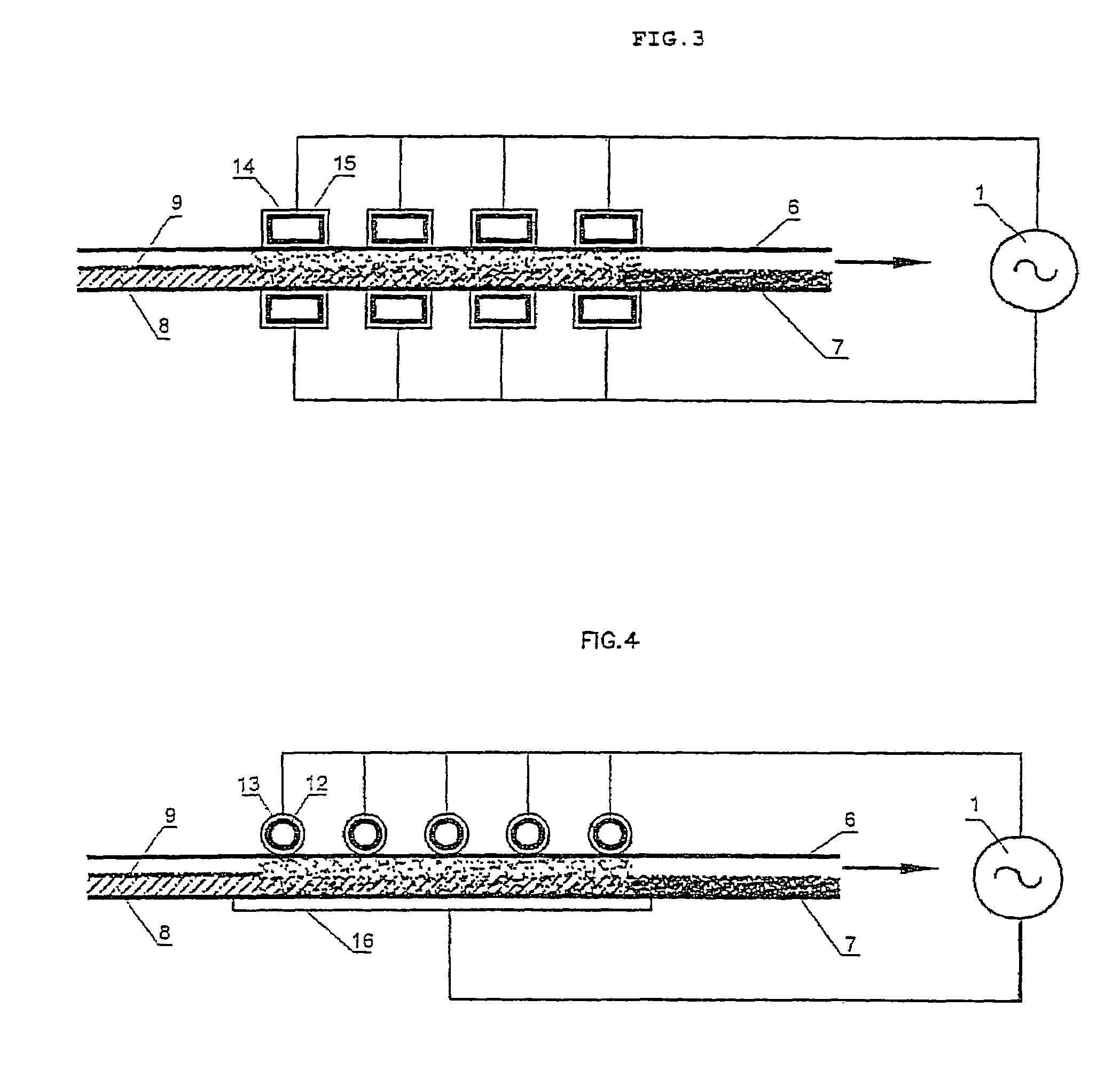Process for impregnating a fibrous, filamentary and/or porous network with powder using electrodes subjected to an AC electric field
a technology of ac electric field and impregnating capacity, applied in the field of new materials, can solve the problems of reducing the mechanical properties of composite materials, requiring a substantial energy consumption, and limiting the amount of powder used, so as to improve the impregnating capacity of the set up, prevent electrical microdischarge, and improve the effect of impregnating capacity
- Summary
- Abstract
- Description
- Claims
- Application Information
AI Technical Summary
Benefits of technology
Problems solved by technology
Method used
Image
Examples
example 1
[0054]This example was produced with a nonwoven made of natural hemp fibers, weighing 1000 g / m2 and being 9 mm in thickness, and with thermosetting powder of the Bakelite brand, reference 6171TP, having a particle size of less than 100 μm. The upper face of the nonwoven was precoated with 500 g / m2 of powder.
[0055]The whole assembly was then introduced into the impregnation process between two belts at a rate of 2 meters per minute. The electrodes used were tubular electrodes 30 mm in outside diameter, which were placed facing one another. The space separating the upper and lower electrodes was 10 mm between dielectrics. The space between two tubular electrodes of the same potential was 15 mm, i.e. 23 electrodes on each side for a treatment length of 1 meter. A field of 3 kV / mm was applied between the belts in the space where the material to be impregnated was. A residence time of 30 seconds in the machine allowed the nonwoven to be uniformly impregnated with powder.
[0056]After impre...
example 2
[0057]This example was produced with a viscose / polyester spun lace nonwoven weighing 100 g / m2. The surface of the nonwoven was precoated with superabsorbent powder of reference JB 882 from SNF, the powder having a particle size of less than 100 μm.
[0058]The speed of the belts allowing the material to be introduced into the impregnation machine was 4 m / min. The impregnation time was therefore 15 seconds in order to impregnate the superabsorbent into the nonwoven. The electrodes used were tubular electrodes 30 mm in outside diameter in the case of the upper electrode and a flat electrode coated with a 4 mm thick dielectric in the case of the lower electrode. The space separating the upper and lower electrodes between dielectrics was 5 mm. The space between two upper tubular electrodes was 15 mm, i.e. 23 electrodes. The dimensions of the lower flat electrode were 1 m×1 m. The electric field applied to the product was 4 kV / mm.
[0059]It was found that the impregnating powder positioned it...
example 3
[0061]The objective of this example was to thermally set a polyester nonwoven after carding so as to provide it with sufficient mechanical strength for it to be handled and transported. The nonwoven was a 400 g / m2 polyester, which was carded and formed into a web with a thickness of 50 mm. The thermal bonding powder used was a copolyamide powder having a particle size of 80-200 μm obtained from Abifor.
[0062]After the phase of powder-dusting the surface of the nonwoven, the material was compressed to 30 mm between the belts so as to be introduced into the impregnation machine. The electrodes used were tubular electrodes 30 mm in outside diameter, which were arranged in a staggered fashion. The space between two tubular electrodes of the same potential was 15 mm, i.e. 23 electrodes on each side for a treatment length of 1 meter. A speed of 2 m / min was used, i.e. an impregnation time of 30 seconds; this allows all of the thermal bonding powder to be dispersed within the volume of the n...
PUM
| Property | Measurement | Unit |
|---|---|---|
| electric field | aaaaa | aaaaa |
| AC voltage | aaaaa | aaaaa |
| width | aaaaa | aaaaa |
Abstract
Description
Claims
Application Information
 Login to View More
Login to View More - R&D
- Intellectual Property
- Life Sciences
- Materials
- Tech Scout
- Unparalleled Data Quality
- Higher Quality Content
- 60% Fewer Hallucinations
Browse by: Latest US Patents, China's latest patents, Technical Efficacy Thesaurus, Application Domain, Technology Topic, Popular Technical Reports.
© 2025 PatSnap. All rights reserved.Legal|Privacy policy|Modern Slavery Act Transparency Statement|Sitemap|About US| Contact US: help@patsnap.com



